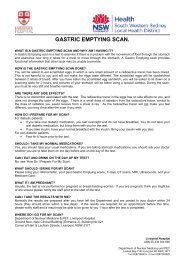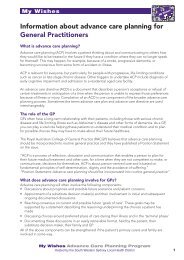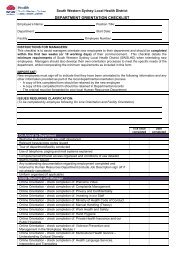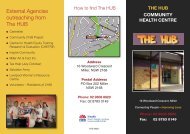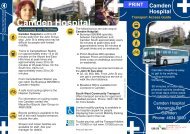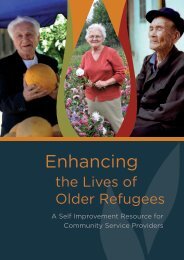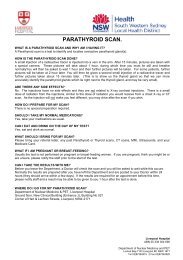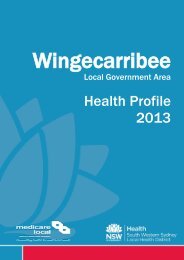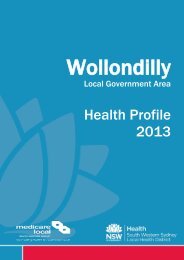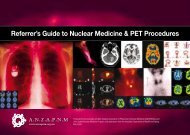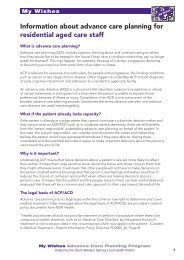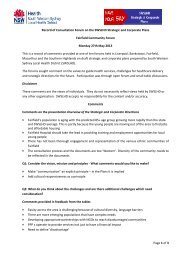Issues Paper - South Western Sydney Local Health District - NSW ...
Issues Paper - South Western Sydney Local Health District - NSW ...
Issues Paper - South Western Sydney Local Health District - NSW ...
Create successful ePaper yourself
Turn your PDF publications into a flip-book with our unique Google optimized e-Paper software.
A Research Strategy for <strong>South</strong> <strong>Western</strong> <strong>Sydney</strong> <strong>Local</strong> <strong>Health</strong> <strong>District</strong> – <strong>Paper</strong> No.1 <strong>Issues</strong> Final April 2012• Annual and targeted research forums which provide opportunities for showcasinglocal health research, networking and discussing new findings.The achievements in leadership place SWSLHD in a strategic position to capitalise on the<strong>NSW</strong> Research Review recommendations. However the consultations with clinicians,managers and staff identified that there is no consistent message about the importance ofresearch from the Board down. This is reflected by the variability across facilities, services andprofessions in the amount of research conducted, the financial and other supports providedand expectations for accountability and reporting. For example some services incorporateresearch and research based practice into the duties of all staff whereas other services seeresearch as outside their role. In addition to the efforts to establish the Ingham Institute, thedecision by the SWSLHD Board to establish a Research and Education Subcommittee is animportant initiative however the need for ongoing concerted leadership for research from anexecutive level (Board, Chief Executive, <strong>District</strong> and Facility and Clinical Leaders) was seen ascritical for developing a research culture. Lack of accountability will maintain the existingethos and for this reason reporting on research performance is also seen to be essential.The need for the <strong>District</strong> to develop a strong research profile within <strong>NSW</strong>, nationally andinternationally was seen as essential for attracting and retaining high level researchers.However the deficits in infrastructure (physical assets, systems and people) meant that the<strong>District</strong>s research profile was not high. As one researcher expressed it “<strong>South</strong> <strong>Western</strong> <strong>Sydney</strong>is seen as a good source of research participants, however staff are not routinely credited forinvolvement in externally lead research and without this recognition, our researchers are lesslikely to be successful in grant applications”. Leadership will therefore not only require a clearmessage but also action.Some senior medical staff proposed research qualifications/experience as a prerequisite forsenior positions. While this may be feasible for medicine particularly as hospitals furtherdevelop their teaching role, it may not be easily achievable for nursing and allied healthprofessionals who have not had the same tradition or opportunities for further education.Summary of issuesLHD needs a strong research profile to attract and retain high quality staffImportance of research needs to be consistently recognised in LHD facilities.The number of staff with research qualifications needs to be increased.More research activity should be initiated or directly involve staff from the LHD2. The Relationship between SWSLHD and the Ingham InstituteAlthough originally incorporated under the control of the former <strong>Sydney</strong> <strong>South</strong> West Area<strong>Health</strong> Service (SSWAHS), the Ingham Institute for Applied Medical Research was establishedas an independent legal entity with its own Board of Directors and Executive managementteam in late 2008. Despite its independent status, there are numerous interdependencies inthe roles and functions of the Institute and SWSLHN.There was a lack of consensus regarding the future role of the Institute within the <strong>District</strong>.While some clinicians/researchers argued that the Institute should be the main vehicle for<strong>District</strong> research and management, others indicated that they could see stronger separationin the longer term. This raises fundamental questions regarding their respective roles andfunctions in research direction, communication with external bodies, performancemonitoring and reporting, and promotion and fund raising. It also raised questions about howSWSLHD| 7



